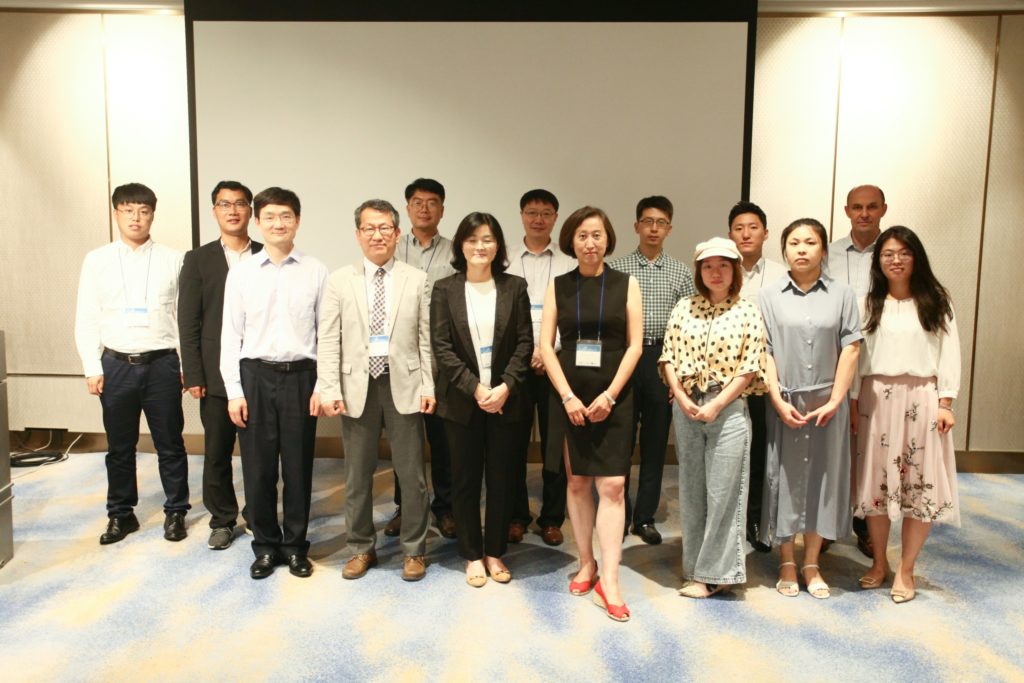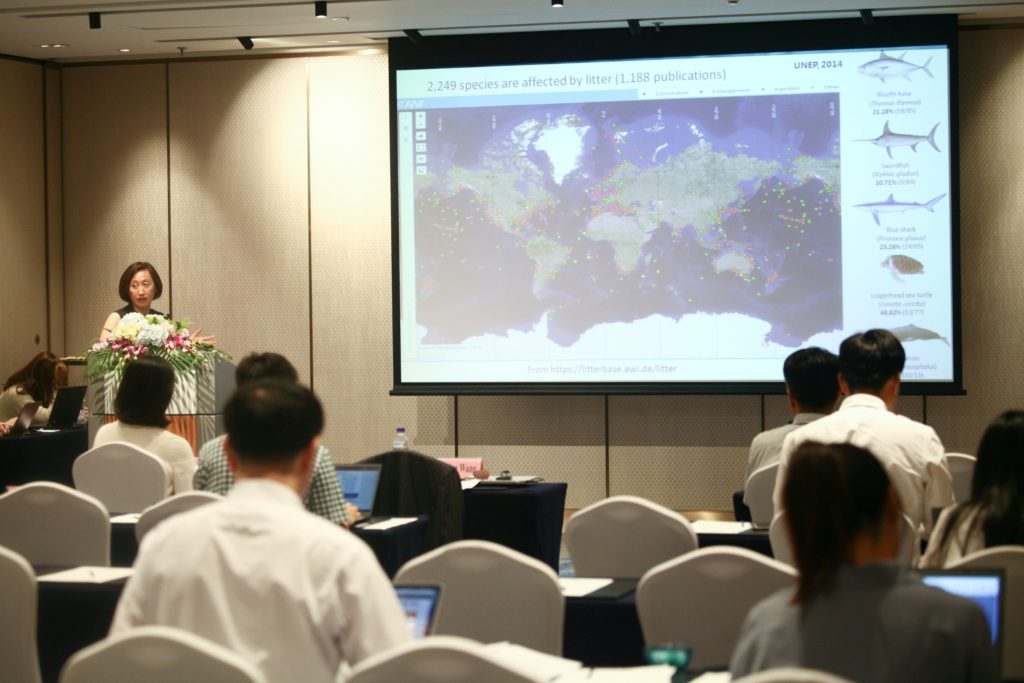
The parallel event on marine litter and microplastics was held in Qingdao City of PR China on 18-19 July of 2019, co-organized by YSLME PMO in collaboration with NMEMC of PR China and KIOST of RO Korea.
The objectives of the session are to:
- Appreciate the methodologies in monitoring and analyzing marine litter (including micro-plastics) in the marine environment of the Yellow Sea;
- Understand the sources and distribution;
- Identify solutions and good management practices to management challenges; and
- Engage local governments and the public to take actions and remediation measures.
Mr. Zhengguang ZHU, Environment Officer from YSLME PMO gave the congratulatory speech. He warmly welcomed all the participants and briefly introduced the schedule of the meeting. Dr. Juying WANG from NMEMC of Ministry of Ecology and Environment, PR China, as the moderator, shared a brief story about YSLME and expressed her enthusiasm and expectations for the organization.
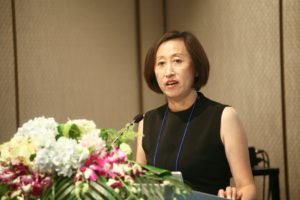
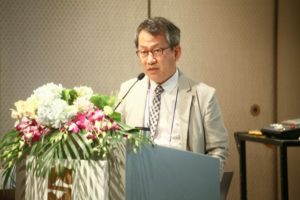
DAY 1
Under Session 1, speakers mainly talked about monitoring and analyzing methodology of marine litter in the marine environment of Yellow Sea.
The session was opened by a keynote address by Mr. Won Joon Shim from Korea Institute of Ocean Science and Technology (KIOST). Mr. Shim introduced the weathering and fragmentation process of plastics from macro to micro-plastics. Citing various environmental samples, microplastics have been found from river, water, air, seawater, STP effluent and biota. He explained how macro-plastics convert into micro-plastics, a process which goes through diverse routes and cannot be seen by naked eyes. In a study conducted by his team, it was found that a month’s sunlight exposure is enough to produce nano- and micro-sized particles. Rapid fragmentation occurs on surface of plastics exposed to sunlight and from which large amounts of nano-sized particles are produced but mass contribution was considered negligible compared to micro-sized particles. Their team will be conducting further studies to test the weathering of other common polymers, rate of fragmentation on water surface, etc.
The second keynote speaker, Dr. Juying WANG, cited several literatures or study which indicated the increasing proportion of solid waste in coasts and oceans ever since the large-scale production of plastics began in 1950s. Based on UNEP (2016), solid wastes both from land-based and sea-based sources represent up to 80 percent of marine litter found in surveys. She mentioned the impacts of macro-plastics and micro-plastics in three aspects: economical, physical and chemical. However, Dr. Wang emphasized that lack of standardized protocols greatly hampers data comparison across studies from specific regions, risk assessment of ecological and human health impacts, and the development of appropriate management and mitigation policies. Current governance strategies and approaches are still fragmented in approach and do not adequately address marine litter and microplastics. She believes that holistic approaches are needed to address the multifaceted, widespread and complex nature of this issue.
Session 2
Mr. Jong-Joo YOON, RO Korea, moderated Session 2 focusing on The Source and Distribution of Marine litter in Yellow Sea.
Mr. Juyong PARK, KOEM, RO Korea, introduced the status of marine litter in Korea and initiatives being undertaken to address the issue. 176,000 tons of marine litter is generated every year in RO Korea, 67 percent of this comes from land-based sources, while 33 percent is sea-based. In the YS area, the National Marine Litter Monitoring in RO Korea found that 77 percent of marine litter came from plastics and styrofoam. From 2012- 2018, total of about USD 46 million has been expended on removal of marine litter by RO Korea. From 2009- 2013, the 1st National Marine Litter Management Plan was implemented followed by the 2nd Plan covering 2014-2018. Building on this the 3rd Plan 2019-2023 is now in place, which aims to strengthen marine debris management at each stage and switch to a scientific and prevention-oriented management plan. As part of future actions, new laws are being developed in RO Korea: Marine Waste Management Act, and Fishing Gear Management Act.
Mr. Maowei JU from NMEMC, PR China, presented the status of marine litter in YSLME including the consolidated baseline report supported by YSLME project. Based on global plastic production data, China is currently the largest producer of plastic followed by Europe. To address this concern, since 2007, the then State Oceanic Administration of China carried out the National Marine Litter Monitoring Programme, in 50 survey locations were along coastal areas, whereby 11 are located at Yellow Sea. In 2016, Marine Microplastic Monitoring Programme was launched and monitored in 17 stations in the YS the same year the Guidelines for Marine Microplastics was also released. Although China was considered a hotspot of plastic debris pollution, based on data collected and compared with other published reports, microplastic density in the Yellow Sea was found to be in the lower-middle level.
Ms. Liping YOU from Shandong Marine Resource and Environment Research Institute, PR China, introduced the status and current regulatory measures of Weihai Litter management. As part of its regulatory measures, Weihai established a coordinating body supported by technical working groups to address marine litter. Two key regulations are being implemented the Regulation on the Protection of Urban Features and Regulations on the Protection of Coastal Zones. Weihai is implementing a number of activities involving the public as part of its marine litter prevention and control initiative. Weihai became the first national demonstration area of marine ecological civilization, and even established a sister-city partnership with New York, USA. But addressing marine litter problem requires continuing efforts and as scuh Weihai intends to further strengthen the implementation of its marine litter prevention and control program, invest more on science and technology, established stronger collaboration, further improve marine litter monitoring and evaluation system, and further enhance publicity and educational campaigns on marine litter management.
Session 3
Mr. Maowei JU from NMEMC of PR China, moderated session 3 of Special session on Microplastics in YS.
Ms. Sang Hee Hong, from KIOST, RO Korea presented on the historical and vertical distribution of micro-plastics in costal and shelf waters from YS of ROK. Their study showed the following: (a) relatively high microplastic contamination level was found in Korean coastal and shelf waters; (b) the positive correlation between microplastic abundance in coastal water and surrounding population indicates input of microplastics from the land-based sources; (c) Although the levels are lower than the surface water, sub-surface water contained considerable levels of microplastics including low-density polymer (e.g. PE and PP). Ms. Hong indicated that further study is required to evaluate relative contribution of various biological interactions for the downward movement of microplastics.
Ms. Xiaoxia SUN from the Institute of Oceanology of Chinese Academy of Science introduced micro-plastics in seawater and indicated the distribution of micro-plastic being discharged into seawater and ingested by zooplankton and fish. Studies have proven that ingestion of microplastics by zooplankton is the fundamental link for microplastics in entering the food web. As such studies on this is important so as to evaluate the potential risk of microplastics to humans. In the studies conducted, it was found that the risks of micro-plastics in the north and south part of the YS is higher than the middle part and the concentration of the MPs is not high indicating that the ecologically relevant concentration and characteristics should be considered for further controlled experiments and risk assessment.

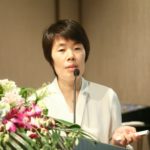
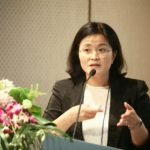
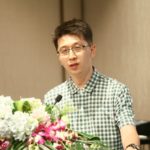
DAY 2
Session 4
The morning session was moderated by Dr. Ning LIU, NOWPAP of UNEP.
Mr. Jong-Joo YOON from ChungNam Institute, RO Korea presented on status and programs to mitigate marine litter in Chungnan Province in RO Korea. He first talked about the trends of marine litter issues and its accompanying damage. He introduced the marine litter monitoring system in ChungNam which is carried out bimonthly covering 60 survey points every 10 kilometers. In 2016, comprehensive management measures for marine litter were established in Chungnam with 60 detailed action policies. The province’s integrated improvement measures also included four main plans divided into coastal litter, fishery litter, deposited litter, and island-left litter. Each year more and more projects are being introduced and in 2018 a total of KRW 18.8 billion was invested in 43 projects. To date, the amount of marine litter collection in Chungnam accounts for 17 percent of the nation’s collection and has the third largest local government portion in RO Korea.
The second speaker is Mr. Feng XIAO from Rendu, currently the only nonprofit organization in China focusing on marine debris issue. The Shanghai Rendu Ocean NPO Development Center is focusing on 4 key areas: coastal cleanup; environmental education, monitoring and research, and network building. In 2014, the Coastal Cleanup and Monitoring Project (CCMC) and network was launched. On the assessment of fishery-based marine litter in Yellow Sea, Mr. XIAO indicated that monitoring sites were established in 4 cities (Dalian, Yantai, Qingdao and Lianyuangang). Based on their experience the group further revised the data card used to collect fishing gear data in more detail. Monitoring method was also further modified to ensure better data quality. From May to late September 2019, the group will carry out 24 monitoring activities at 8 sites. Results of the monitoring reports will be reviewed by OSEAN and will be finalized by November 2019.
Ms. Zhenzhen LI from the BlueRibbon Conservation Association, shared the work of BROCA in establishing an ocean conservation network in China that is aimed at promoting ocean education, awareness, clean-up and coastal ecosystem conservation. Ms. Li cited the different accomplishments and outputs of the group under its 5 key program areas: (1) Blue Data; (2) Call for Blue Ocean; (3) Blue Forces; (4) Blue Volunteers; and (5) Blue Dialogue.
Ms. Liwen CHEN, from Zero Waste Villages, PR China started off with her personal story and realizations about waste in China. She highlighted the pollution caused by open-dump, landfill and incineration, the accompanying economic costs of burning wastes (i.e., over 1,000 RMB per ton), and environmental costs (i.e., mercury emission, dioxin, etc.). In 2015, the Waste Management Department issued a Guide to rural waste management, and a three-year planning for improving living environment in the countryside was issued in 2017. In Dongyang, Jiangxi province, for instance, over 90 percent of organic waste goes to composting, farmers get the organic fertilizer for farming, and over 90 percent of families have been observed to have undergone behavioral change. In promoting zero waste, the group promoted door-to-door communication changing behavior towards waste management one family at a time, while township and county government help with inspection. Results of waste separation were also published in the villages. The group believes that engaging stakeholders in the initiative is the key.
Session 5
The session 5 of Synergizing actions of responses to marine litter and micro-plastics through cooperation at regional level was moderated by Mr. Zhengguang ZHU, Environment Officer of YSLME.
Mr. Ning LIU from NOWPAP introduced the NOWPAP Regional Action Plan on Marine Litter and NOWPAP’s mechanism. He highlighted the different outputs/ accomplishments made by the different NOWPAP regional activity centres under the three key elements of the Regional Action Plan: (a) prevention of marine litter input; (b) monitoring quantities and distribution of marine litter; and (c) removal of existing marine litter. In 2007 and 2011, NOWPAP published the 1st and 2nd Regional Overview on Marine Litter in the NOWPAP region. By end of 2019 the 3rd Regional Review on Marine Litter will be published. Apart from these reviews, NOWPAP also continues to organize International Coastal Clean-up campaigns in Korea, China, Japan and Russia. In September 2019, NOWPAP will undertake a Joint NOWPAP-Tripartite Environment Ministers Meeting Workshop on Marine Litter Management, and a Second Experts Group Meeting on NOWPAP’s special project on “Monitoring and Assessment Methods for Microplastics Pollution”.
Mr. Maruf from Xiamen University, PR China, discussed national policies and management of marine litter in Southeast Asian countries. While each of the countries in Southeast Asia have started to put in place policies to help manage marine plastic litter, existing regional cooperation still needs to be further strengthened. Mr. Maruf believes that the platform provided by China’s 21st Century Maritime Silk Road (MSR) with a vision of strengthening maritime cooperation may be an option to address marine environmental problems in the region, particularly transboundary pollution.
The last speaker is Mr. Zhengguang ZHU, who introduced the ways of building a sustainable platform for innovation and learning across cities in YSLME through establishing a city alliance.
